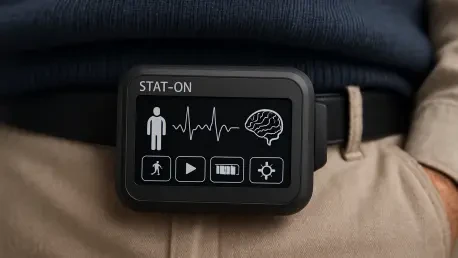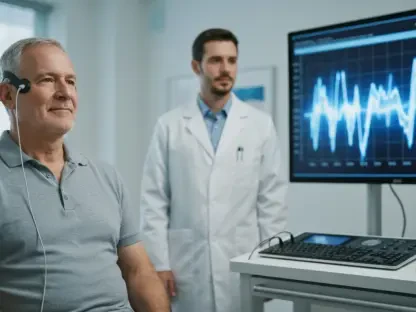In a quiet suburban home, an elderly man struggles to pour a cup of coffee, his hands trembling uncontrollably as the liquid spills over the counter, a scene repeated daily for millions with Parkinson’s disease (PD). This heartbreaking reality captures the profound impact of a condition that affects 7 to 10 million people worldwide. Beyond the physical challenges, the emotional and financial burdens weigh heavily on patients and families, often leaving them searching for better ways to manage an unpredictable illness. What if technology could offer a lifeline, providing clarity and control where uncertainty reigns?
Why Parkinson’s Care Needs a Technological Breakthrough
The complexity of Parkinson’s disease lies in its progressive nature and the difficulty of tracking symptoms that fluctuate hourly. Traditional methods rely on infrequent clinical visits, often just 20 minutes every six to nine months, which fail to capture the full scope of a patient’s condition. This gap in monitoring leads to delayed interventions and suboptimal treatments, exacerbating the challenges faced by both patients and healthcare providers. With projections estimating up to 25 million cases globally by 2050, the urgency for innovative tools to revolutionize care has never been greater.
The strain on healthcare systems is equally alarming, with misdiagnosis rates as high as 40% and annual costs per patient averaging around $12,500 in Europe. These figures highlight a pressing need for solutions that can scale to meet growing demand while improving accuracy in diagnosis and management. Technology, particularly wearable devices, stands poised to address these systemic shortcomings by offering continuous, data-driven insights into a patient’s daily life.
Unveiling STAT-ON™: A New Era of Symptom Tracking
At the forefront of this technological wave is STAT-ON™, an AI-powered wearable device worn on the waist to monitor Parkinson’s motor symptoms with remarkable precision. Unlike wrist-worn trackers, this tool focuses on axial symptoms affecting the trunk and lower limbs, providing a detailed picture of mobility challenges often missed in brief clinical assessments. Its ability to record medication intake and securely store data for clinician access via a smartphone app makes it a practical asset in modern healthcare settings.
The real strength of STAT-ON™ lies in its capacity for real-time monitoring, capturing symptom fluctuations throughout the day. For instance, it can detect subtle changes in gait or posture during routine activities like walking to the store, offering neurologists a comprehensive dataset to tailor treatments. Validated against conventional tools in hospital environments, this device proves its reliability, paving the way for a shift from reactive to proactive care strategies.
Evidence That Speaks: The Impact of STAT-ON™
Research underscores the transformative potential of STAT-ON™, with a study published in PLOS ONE by Daniel Rodriguez-Martin projecting cost savings of up to $150 million in Germany and $21 million in Sweden through early symptom detection. These numbers reflect the device’s ability to reduce hospitalizations and long-term care needs by enabling timely interventions. Such economic benefits provide a compelling argument for integrating this technology into national health systems.
Neurologists have also voiced strong support, noting that STAT-ON™ bridges the gap between sporadic clinic visits and the day-to-day realities of living with Parkinson’s. Patients, too, report tangible improvements, with telemedicine trials revealing enhanced balance and emotional well-being. One participant described feeling “more in control” of their condition, a sentiment that highlights the personal impact of having consistent, objective data to guide their care journey.
Overcoming Barriers: Integrating STAT-ON™ Into Everyday Care
Implementing STAT-ON™ into clinical practice requires strategic planning to ensure seamless adoption by healthcare providers and patients alike. Training programs for medical professionals are essential to interpret the detailed reports generated by the device, enabling them to make informed decisions based on real-time data. Partnerships with patients to encourage consistent usage, such as through user-friendly app interfaces, further enhance the tool’s effectiveness in daily routines.
Challenges, such as potential increases in medication costs due to more precise prescriptions of advanced treatments, must be addressed through a focus on long-term savings. Leveraging telemedicine for remote monitoring can also expand access, particularly for those in rural areas with limited specialist availability. By tackling these hurdles, STAT-ON™ can become a cornerstone of personalized Parkinson’s care, aligning with broader trends toward data-driven health solutions.
Practical Pathways: Making STAT-ON™ a Reality for Patients
Looking ahead, actionable steps emerged from discussions around STAT-ON™ that could shape its role in transforming Parkinson’s management. Healthcare systems must prioritize pilot programs to test the device across diverse populations, ensuring its benefits translate to varied demographics. Collaborations between technology developers and policymakers are critical to address reimbursement challenges, making the tool accessible to a wider audience.
Patient education also plays a pivotal role, as empowering individuals with knowledge about how STAT-ON™ works helps build trust and adherence. Reflecting on these efforts, the journey of integrating such innovations reveals a broader potential to redefine chronic disease care, setting a precedent for other conditions. The path forward demands sustained commitment to research and adaptation, ensuring that yesterday’s breakthroughs become tomorrow’s standard of care.









